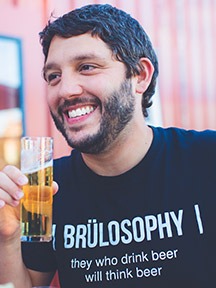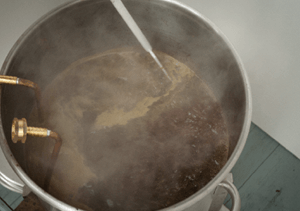Boiling Wort: Tips from the Pros
Wort is boiled for numerous reasons, including sanitation, to eliminate undesirable compounds, to extract bitterness from hops, flavor development, and more. As no-boil brewing gains interest and extended boils remain popular for some big beers, we wanted to get the views of what these experts do when the heat is cranked under the kettle.

Marshall Schott, Founder of Brülosophy (www.brulosophy.com)
Generally, if I’m brewing a single all-grain batch of a style that’s not going to be really bitter then I’ll boil for 30 minutes with a slightly larger initial addition of a high-alpha hop to achieve the desired bitterness. If I’m brewing anything more bitter than a standard American IPA, I’m likely sticking with a 60-minute boil, as well as when I’m brewing two batches simultaneously only to save my sanity. I’m no longer convinced extended boils are necessary to reduce Dimethyl Sulfide (DMS), so no more boils of 90+ minutes for me. I’d stick to the shorter boils for most styles when doing extract batches as well, as the decision is based largely on isomerization of alpha acids, as well as convenience. While multiple exBEERiments have indicated the risk of DMS due to boil length is low when brewing all-grain, it’s essentially non-existent when using extract, at least as a function of boil length.
We’ve conducted a number of boil-length experiments that were documented on Brülosophy. When comparing an American pale ale made with pale and Vienna base malts where one was boiled 30 minutes and the other was boiled for 60 minutes, tasters were unable to reliably distinguish them. In a follow-up exBEERiment, tasters were also unable to consistently tell apart a Kölsch-style beer made with 93% Pilsner malt that was boiled for 30 minutes from one boiled 90 minutes. We sent samples of the beers from the latter exBEERiment to a lab for objective analysis, and those results indicated neither beer contained measurable levels of DMS. Given the results, I no longer worry about extended boils for the purposes of DMS mitigation. There may be other benefits though. I’ve heard good things about extended boils when making certain Scottish ales.
In addition to length, we’ve done two exBEERiments looking at the impact boil vigor has on beer character, one on an American amber ale and the other a German helles exportbier, and both returned non-significant results.
Prior to completing the boil length exBEERiments, I definitely accepted what I’d been taught about the correlation between the presence of DMS and boil length, especially as it pertains to lagers made with a large amount of Pils-ner malt. I no longer worry about this at all. Boil vigor is something I never really worried about, in part because I’ve never had an issue achieving a rolling boil, and the results of our exBEERiments only served to validate my lack of concern.
I’ve never made a true no-boil beer, but two past exBEERiments completed by Brülosophy contributors indicated tasters could reliably distinguish a no-boil Berliner weisse from one boiled for 45 minutes and a no-boil Scottish heavy from one boiled for an hour. During the COVID pandemic, when we were unable to collect data from tasters, contributor and host of The Brü Lab podcast, Cade Jobe, replicated the no-boil exBEERiment on a hazy IPA and was unable to reliably tell those beers apart. Of course, the no-boil beer in all three cases had a lower OG than their boiled counterparts.
Another boil-related exBEERiment I want to do is comparing a Scottish ale boiled 60 minutes to one boiled for 3–4 hours where the amount of boil-off is compensated for. I’ve wondered if the characteristic caused by an extended boil is really due to caramelization and/or the Maillard reactions, or if it can be better explained by extended boils simply producing a more condensed wort.

Van Havig is the Master Brewer at Gigantic Brewing Co. in Portland, Oregon.
We boil for 90 minutes for any “standard” sort of ale or lager. Why? Because I’ve always done it. I know that’s not a good answer from a technical brewing standpoint, but it is from a brewhouse process and consistency standpoint. In a brewery, sometimes there are considerations for how you do things that have less to do with the beer itself and more to do with operating the brewery. That 90-minute boil could easily be only 60 minutes, but when we’re double brewing (two kettle fills in a day), the spacing of the first and second brew is a little easier with that extra half hour. It’s all about the timing of knocking out the kettle and the second mash and vorlauf. When brewing a single, we still do a 90-minute boil for consistency. And consistency is of paramount importance in a commercial brewery.
An exception to this is our barleywine Massive! that is boiled for a minimum of eight hours, usually about nine. We mash in at 6:30 a.m. with a grist of 100% pale ale malt (we select a new malt every year for fun) and are typically into the boil around 10 a.m. with a 1.065 specific gravity (16 °P) wort. The goal is to boil this down until we reach at least 1.115 (27 °P). At that point we’ll have reduced our wort volume by about 1⁄3. What you get is a richly mahogany-colored wort that’s very attenuative. The all pale malt grist lautered to a reasonable gravity means that you get a wort comprised of a very favorable percentage of glucose and maltose compared to tri-glycerides. When you boil it for an extended period, Maillard reactions increase throughout the boil, leading to much more color generation and caramelization than in a shorter boil. The boil is so long that you actually get two hot breaks, an initial one and then another after about six hours or so. The long boil seems to also help break down some of the sugars more, leading to greater fermentability. When we ferment this wort, it will attenuate down to below 1.024 (6 °P), sometimes below 1.020 (5 °P). This makes the beer rich and strongly alcoholic, but not overly sweet and syrupy like a pastry stout. So long story short, the long boil gets you great flavor generation while at the same time creating an incredibly attenuative wort. I don’t think there’s another way to really get this flavor profile. To get the rich, caramelly, treacly character of the beer you’d have to use quite a bit of crystal malt, and then it wouldn’t attenuate nearly enough, or alternatively it wouldn’t be nearly strong enough.
The other exception to our 90-minute boils are kettle sours, which we typically boil 15–30 minutes, varying the time only to adjust gravity. Frankly that’s because we just want to get on with our day after waiting nearly 24 hours since we lautered the wort. DMS is still an issue, but we have simple ways of dealing with that – namely a piece of copper right before the heat exchanger.
For many, the standard boil is 60 minutes for two reasons. Boiling for that amount of time pretty much guarantees you drive off DMS. Second, if you add hops at or before boil on a 60-minute boil you get close to the maximum amount of hop utilization that’s possible. You’ll get more in a 90-minute boil, but it’s not a lot more — it is among the reasons the Germans boil for 90 minutes; however, what with their focus on efficiency. That 60-minute number comes from standard British brewing practice. And let’s remember, American homebrewing comes from British homebrewing, which comes from British brewing practice. It all comes down to cost vs. time. Do you use a tiny bit more hops and boil for a little less time? You save some energy cost that way, as well as labor costs. Or you maximize your hop utilization, extra guarantee no DMS (much more important in lagers) at the cost of labor and energy. For homebrewers, I’d do what feels right to you. Frankly, I’d probably base my boil time on elevation (higher = longer) for DMS and hop utilization reasons.
Boiling is a process just like milling, mashing, and lautering. As such, how you go about it is important. Time can matter in terms of how the finished beer tastes. Also, how hot your kettle is before wort hits it can make large changes in flavor. Think of it as a process and how the sub-processes of hop utilization, caramelization, sterilization, etc., can affect your final beer. A sophisticated brewer knows it’s not just putting sugar water in a kettle and heating it up.


